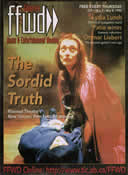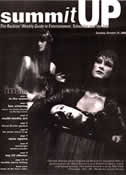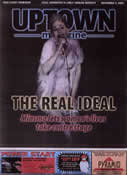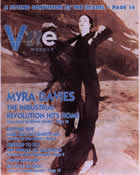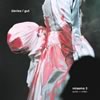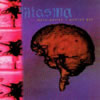|
interview on catascopic.com:

M
is for Multifaceted
In Germany, Gudrun Gut's name is synonomous with many facets of
the art world, from music to performance art - to say that this
woman has been busy is an understatement. Owner of a music venture,
M-Enterprises,
record label, producer of a radio show in Berlin with Thomas Fehlmann,
and being member of seminal post punk art group, Malaria, are
the spokes of GG's world. As a result, M-Enterprises, Moabit records,
The Ocean Club, and the release of Malaria Compiled 82-84, and
Malaria Revisited, GGs world has not been confined to just Europe
over the years. Her collaborations, past and present include familiar
names, as well as obscure ones, but all have a creative, high
quality experimental tone that covers everything from rock to
electronic music. Electronic music is where she first began her
musical foray in the early 80s, and now, as the same kind of experimentation
takes the limelight again, so does the chance for Gudrun's many
projects to come to fruition. [LG]
Did you find it harder or easier when you began experimenting
with MIDI, or now, experimenting with similar electronic technology,
especially as a woman?
Harder or easier than what? It was the most natural development
for me- I was excited about it. We wanted to know how it works.
No real problems- I had some friends I could ask as well. Still
now I like trying things out. I'm not at all scared of technics.
I'd rather get my fingers burnt - I'm a learning by doing person.
At one time I had an English-speaking boyfriend musician and he
couln't read the German manuals - So I did and explained the equipment
for him. It's not a big deal. Some males are much worse than female
with this!
What was the catalyst in creating Mania D? How does that group
compare to Chicks
on Speed? Did COS get their concepts of Art production/destruction
in the realm of commerce from this precursor? Was the reaction
the same as how people are receiving COS now?
We founded Mania D because we were sick of the music around. It
had nothing to do with real life and with our interest - the mainstream
music was overproduced and boring. That was the main reason to
start the band for me.
Some silimalrity to COS is the connection to art - we did shows
in galleries with Kippenberger etc. I thought Malaria was a bit
like COS speed as well - because of the very powerful attitude.
What spawned your involvement in industrial/electronic band
Einsturzende
Neubauten? Did you get into the musical realm of experiemental
art through involvement in Mania D, or earlier with Din a Testbuild?
My interest in more extreme music began already with school when
I worked at an underground mailorder distribution. Din a Testbuild
was a testing ground but [it was] too many boys who knew exactly
what they wanted and how it all works and I couldnt find a place
for myself in that - it was not what I wanted. In Mania D we had
fun together and we were three equal women. Bettina and I were
at art school then, Beate worked as a technician for a Berlin
radio station. Einstrzuende
Neubauten came later. With Mania D we had our rehearsal room
at Blixa's
[Bargeld of Einsterzende Neubauten] apartment for a while. We
were friends with similar musical taste. It was natural that we
helped each other out - so Beate and I were in the founding group
of EN in 1980 and did some gigs with them at the beginning - because
we were friends. But Mania D was definitely the more important
band for me at that time. We were active girls and had lots of
projects then.
Was your work with Manon and Beate in Matador your first foray
into filmworks? How was the tour with that band different from
the Malaria tours, or work with similar projects?
Malaria was more song orientated and fitted somehow in in the
alternative rock formula. We were touring a lot and had a manager.
With Mania D and later with Matador it was more experimental and
the aim was to try out more corners and search for new possibilities.
So we did involve performance art and film. We wanted to force
ourselves and our creative output and not only reproduce already
written material. We wanted to get out of the marketing and selling
process and that's what we did with doing tape only releases etc.
but not only that- with Matador we began programming (atari) and
got our own recording facilities which was very good for producing
the records we wanted and the freedom of taking the time you need
to record and write songs.
During the fist Malaria reconnaissance, how did you hook up
with Jim Thirwell
as a producer on the "Old Man River" recording (on the Elation
EP, Moabit Records, 1992)?
We knew Jim from old Malaria times. From Malaria playing with
the Birthday Party. And he was friends with them and with Lydia
Lunch. Jim came to Berlin as well and we were friends. We
met him in New York and always liked his work. Since he worked
with the same computer program we wanted to work together and
we all really liked to go to New Orleans- where Bettina was living
then. So we did and recorded Old Man River there and we had a
great time.
What were the events that lead up to another North American
collaboration, Miasma with Myra Davies?
Myra came to Berlin for studying romanticism at Humboldt University.
We met at a party. She showed me her writing and I found it interesting
to create sounds for it- I was working with Matador in the studio
at that time. We tried stuff out when the studio was free. It
worked surprisingly well and it was interesting to me not to do
songs with song lyrics but work with sound and text. She went
back to Canada and we discussed issues via the internet. We continued
working in Canada/Vancouver and back and forth in Berlin and Canada/Banff.
We involved new media, dance and theatre and did big productions
with lots of women involved. We just finished some new tracks
which we will distribute over the net very soon (see the M-enterprise
page - Miasma)
When did you decide to start Monika Enterprises? What was the
main obstacle in getting it off the ground?
In 1997 I stated Monika Enterprise as well as the radio show.
I wanted to do a label for other music than my own (Moabit) for
a long time, the Quarks tape made me start the label - it was
worth putting the work in and it was obvious that no big label
would understand that kind of music - it was not loud rock music
nor industrial and it was not techno. There was this little scene
of bands who played in living rooms in East Berlin. The whole
scene is very friendly and warm and not rocknrollstar like. When
I first saw Barbara
Morgenstern play I really couldn't believe it- She was so
natural with her music and had no star attitude and just did her
songs with her electonic organ and rhythm box. The new signing
is Figurine from America - the band and their music seem so close
and totally Monika fitting. Yeah - the label takes a lot of my
time and energy - but to see the development of all the bands
is very fullfiling. They got really good and are as exciting as
ever.
Can you tell us a bit about Ocean
Club and what is involved in producing your own radio show?
Ocean Club began as a solo project for my recording work including
other artists and it evolved into a real club with DJs and a radio
show. We produce the radio show as if it would be a record (I
do the show together with Thomas Fehlmann and since we both come
from the recording art this seemed the most natural to us). The
music we play is a mix of new electronic, dance, indietronics,
old classics and melancholic love songs and we have spoken word
from Wolfgang Betke,
a mermaid with under waterscience and fortune cookies and a short
guest DJ each week. We still do Ocean
Club nights with different guest artist all over the world
where I DJ as well.
Any other projects in the works for the future?
This year I'd like to do more music again - I just got a new music
program (Ableton Live) and I like to mix some live music with
the djing. Then Monika has lots of new releases coming up and
with Ocean Club - lots of interesting gigs - I know we will be
in London with the Ocean Club on the 12th of April and we are
planing nights in Spain and Barcelona and Switzerland.
-LG

Click here for a Gudrun
Gut Discography
|

